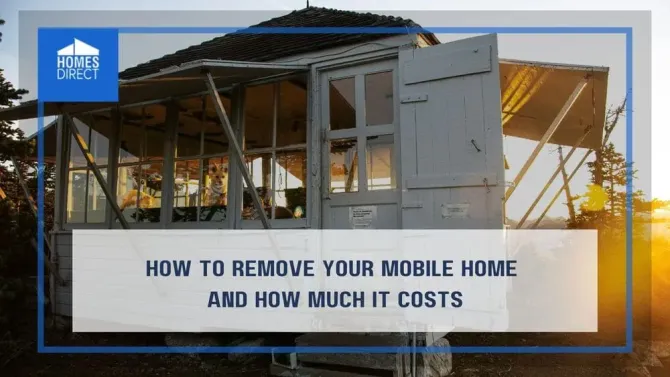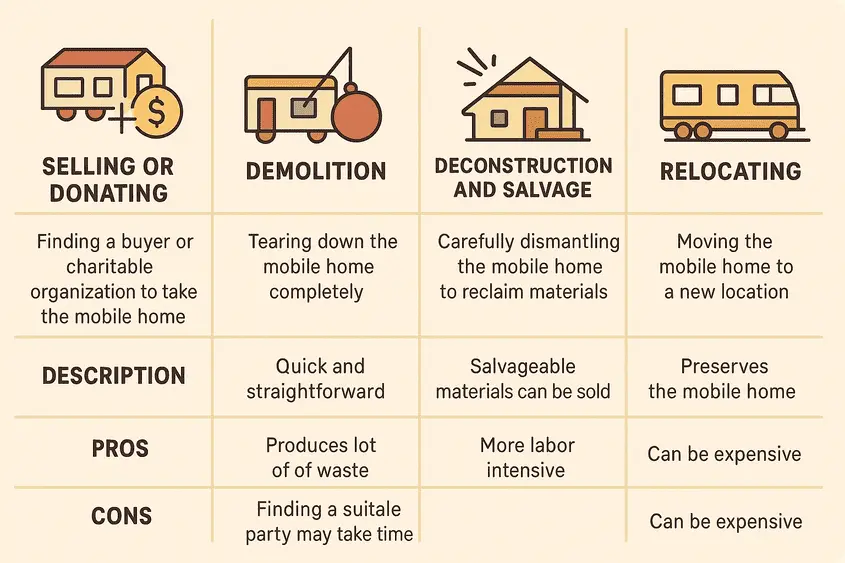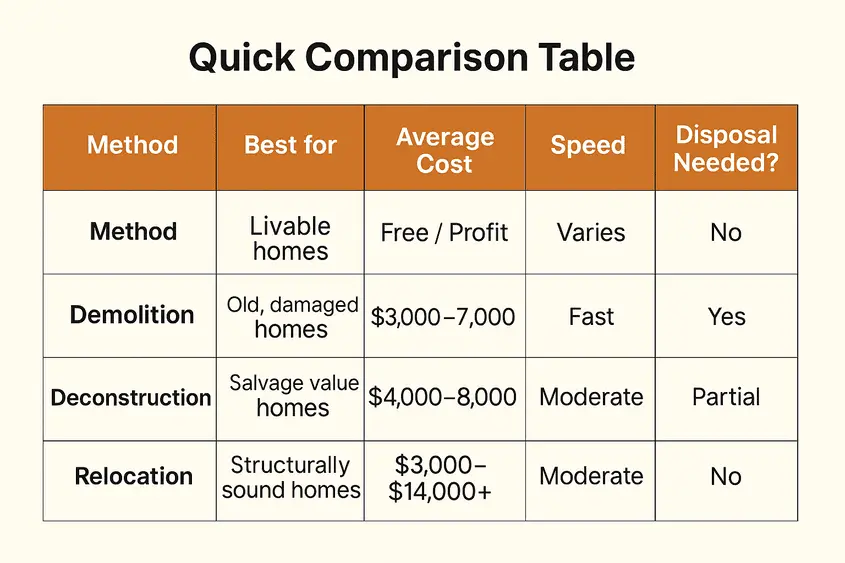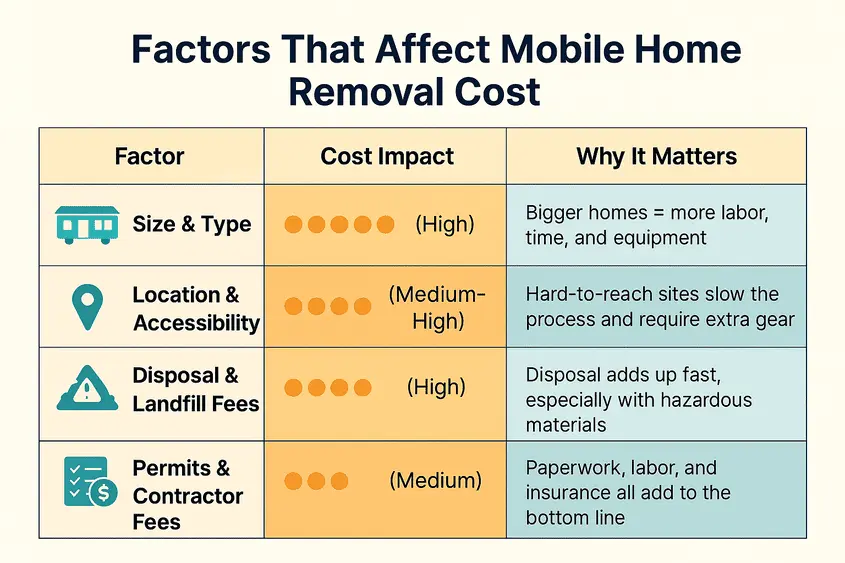Removing a mobile home is a significant undertaking that involves careful planning, understanding of local regulations, and consideration of various disposal methods. Whether you're dealing with an aging structure, repurposing land, or complying with zoning laws, this guide provides comprehensive insights into mobile home removal and associated costs.

If your mobile home is falling apart, no longer safe to live in, or simply taking up space you’d rather use for something else, it might be time to think about getting it removed. Maybe you're planning to build something new. Maybe the home is too old to be worth fixing. Or maybe local rules have changed and keeping it around just isn't an option anymore.
Mobile home removal isn’t always simple. There are different ways to go about it, some more affordable than others, and costs can add up quickly if you don’t plan ahead. From demolition to relocation, there are pros and cons to each approach, and local regulations can also affect what’s allowed on your property.
In this guide, you'll find practical advice on how to remove your mobile home, how much it typically costs, and a few tips that might help you save money in the process.
Reasons for Mobile Home Removal
There are several compelling reasons why mobile home removal may become necessary. Understanding these motivations can help homeowners make informed, cost-effective decisions.
Structural Damage or Deterioration
Over time, mobile homes, especially those built before HUD code improvements, can suffer extensive wear and tear. Exposure to moisture, poor insulation, and outdated building materials can lead to serious issues such as:
-
Mold and mildew infestations
-
Sagging floors or roof collapse
-
Water-damaged walls and insulation
-
Pest infestations
-
Electrical or plumbing hazards
When these problems pile up, repairs may become prohibitively expensive. In many cases, the cost of restoring an old mobile home exceeds its market value. At this point, mobile home removal becomes the most practical solution, especially if the structure poses safety risks or is uninhabitable.
Land Repurposing
Another common reason for removing a mobile home is to repurpose the land for something more valuable or functional. For instance:
-
Building a new site-built home
-
Expanding agricultural use or adding a workshop
-
Subdividing the property for resale
-
Upgrading infrastructure (e.g., septic systems or utilities)
If the mobile home is standing in the way of new development or landscape improvements, removing it allows property owners to unlock the full potential of their land.
Compliance with Zoning Regulations or Park Requirements
Mobile homes are subject to strict zoning laws and park rules, which can change over time. In some cases, older mobile homes no longer meet updated safety, age, or aesthetic requirements imposed by:
-
Local municipalities
-
Homeowners associations
-
Mobile home park managers
For example, some parks restrict homes that are over a certain age (usually 20–25 years), while others mandate exterior upgrades that may not be worth the investment. If a property no longer complies, mobile home removal and disposal may be the only viable option to avoid fines or eviction.
Cost-Benefit Analysis of Removing vs. Repairing
One of the biggest questions homeowners face is whether to remove the mobile home or invest in repairs. To make a smart choice, it’s essential to compare:
-
Repair costs vs. resale value
-
Long-term maintenance vs. upfront removal cost
-
The structural integrity and age of the home
-
Energy efficiency and livability
For example, replacing roofing, siding, plumbing, or electrical systems in a deteriorating structure can cost tens of thousands of dollars, sometimes more than the home is worth. In these situations, old mobile home removal offers a fresh start, enabling homeowners to replace the unit with a newer model or shift toward a permanent structure.
In short, when repair expenses outweigh future value, mobile home removal isn’t just logical, it’s financially responsible.
Different Methods of Mobile Home Removal
Once you've decided it's time to part ways with your mobile home, the next question is how. There’s no one-size-fits-all approach here, the best method depends on the home's condition, your budget, and what you want to do with the space afterward. Below are the four main options:

1. Selling or Donating the Mobile Home
Best for: Homes in livable or fixable condition
If your mobile home still has some life left in it, selling or donating it can be the easiest and cheapest way to remove it. You can list it online, offer it to someone who needs a starter home, or even donate it to a local organization. Some fire departments accept mobile homes for fire training, and charities may take them for affordable housing projects.
Pros:
-
Very low or no cost
-
Avoids landfill fees
-
Someone else takes care of moving it
Cons:
-
Limited to homes in decent shape
-
You may need to pay for minor repairs or prep work
-
Not always quick to find a buyer or taker
Tip: Make sure you have a clear title and the home meets HUD or local livability codes.
2. Demolishing the Mobile Home
Best for: Homes that are damaged, unsafe, or not worth fixing
Demolition is the go-to option when your mobile home is too far gone. Contractors bring in heavy machinery, tear the structure down, and haul away the remains. It’s fast and relatively simple, but it comes with costs, and a lot of debris.
Pros:
-
Quick and straightforward
-
Clears the lot completely
-
Safe for badly deteriorated homes
Cons:
-
Costs typically range from $3,000 to $7,000
-
Requires permits
-
You’ll pay landfill or disposal fees
Tip: Ask the contractor if cleanup and disposal are included in the quote. Some charge extra.
3. Deconstruction and Salvage
Best for: Homeowners who want to save money and reduce waste
This method involves carefully taking apart the mobile home to reuse or sell valuable parts, wood beams, metal siding, wiring, appliances, and more. It's slower than demolition, but you might earn back part of the cost by selling the materials.
Pros:
-
Environmentally friendly
-
May recover money from salvaged parts
-
Less material goes to landfill
Cons:
-
Takes more time and labor
-
You still need to remove leftovers
-
Might not be worth it for very old homes
Tip: Partner with a salvage company or resale store — they may even help with the tear-down.
4. Relocating the Mobile Home
Best for: Homes in good condition that are still road-legal
If your mobile home is in good structural shape and you want to move it to a new location, relocation is an option. But this isn’t just hooking it to a truck and driving away, it involves disconnection, permits, specialized transport, and sometimes road escorts.
Pros:
-
Keeps the home intact
-
Can give the home a second life elsewhere
Cons:
-
Expensive: prices range from $3,000 to $14,000+
-
May not be allowed for homes over a certain age
-
Requires structural readiness and legal clearances
Tip: Always check local transport regulations, many states have age, size, or route restrictions.

Factors That Affect Mobile Home Removal Cost
Mobile home removal costs can vary wildly, from a few hundred dollars to well over $10,000. The final price tag depends on more than just the size of the home. Here are the four biggest factors that impact your total cost and what to expect from each one.
1. Size and Type of the Mobile Home
Why it matters: Larger mobile homes require more labor, equipment, and time.
-
A single-wide is the easiest and cheapest to remove, typically one structure, one team, one truck.
-
A double-wide has to be separated into two parts before moving or demolition.
-
A triple-wide or multi-section home multiplies the effort and cost.
What to expect:
-
Demolition: More square footage = more debris to haul away
-
Relocation: Each section requires its own transportation setup
-
Cost impact: Can increase removal costs by 30%–70%
2. Location and Accessibility
Why it matters: How easy it is to get heavy equipment onto your property directly affects cost.
-
Homes located near wide streets, on flat terrain, are simple.
-
Remote, rural, sloped, or wooded lots often require extra planning, special vehicles, or even partial clearing.
-
Tight city spaces may need a crane or smaller equipment, which takes longer and costs more.
What to expect:
-
Add-on fees for equipment access, clearance, or extra crew
-
Possible delays if terrain slows down demolition or transport
-
Cost impact: May add $500–$2,000 or more depending on difficulty
3. Disposal Fees and Landfill Regulations
Why it matters: After teardown, all that material, drywall, insulation, flooring, shingles, needs to go somewhere.
-
Local landfills charge by weight or volume, with fees averaging $300–$1,000+
-
If your home contains hazardous materials like asbestos, it must be handled by certified professionals and disposed of at approved facilities
-
You’ll also pay more if materials can’t be sorted for recycling
What to expect:
-
Fees per ton at landfill (varies by region)
-
Additional charges for hazardous waste testing, removal, or special transport
-
Cost impact: Can add $1,000–$3,000 if hazardous materials are involved
4. Contractor Rates and Permits
Why it matters: Hiring a licensed, insured contractor ensures the job’s done safely and legally, but that comes with a price.
-
Most contractors include labor, equipment, insurance, and removal in their base quote
-
However, you’ll also need permits, and those are handled separately depending on your city or county
-
Costs for permits vary widely, from $100 to $350+
What to expect:
-
Demolition contractor fees: Typically $1,000–$5,000 depending on region
-
Permit fees: Often not included in quotes
-
Cost impact: Permits and contractor costs can easily make up 30–50% of your total expense

How to Save Money on Mobile Home Removal
Getting Multiple Quotes from Contractors
Prices for mobile home removal can vary more than you’d think. Some contractors include everything, demolition, hauling, cleanup, permits, while others charge separately for each part. That’s why it pays to talk to at least a few different companies before making a decision. Ask for detailed estimates and make sure you understand what’s included. Even small differences can save you hundreds.
DIY vs. Professional Removal
If the mobile home is already partially dismantled, or you have some experience with tools and safety protocols, you might be able to handle part of the job yourself. For example, removing skirting, disconnecting utilities, or tearing down an old porch. Just keep in mind that full demolition or relocation usually requires heavy machinery, permits, and expertise. It’s not always cheaper if something goes wrong, so only go the DIY route if you know what you’re doing.
Recycling and Selling Parts
Before you bring in the bulldozer, take a walk through the home and look for anything you can salvage. Metal siding, wooden framing, copper wiring, appliances, even old windows, all of these can be reused or sold. Salvage yards, scrap metal buyers, and even local handymen might be interested. Not only can this help offset your removal cost, but it’s also a more sustainable option than sending everything to the landfill.
Permit Requirements for Mobile Home Removal
Removing a mobile home isn’t just a physical job, it’s a legal one too. Most cities and counties require permits for demolition, disposal, or relocation. The exact requirements vary depending on where you live, but expect to apply through your local building or zoning office.
Fees usually fall between $100 and $350, and you may need to provide proof of ownership, site plans, or environmental information. It’s not the most exciting part of the process, but skipping it can lead to fines, delays, or even having your project shut down.
Wrapping It Up
Mobile home removal isn’t something most people deal with often, but when the time comes, it helps to go in with a clear plan. The process can feel complex at first, but once you understand your options, know what impacts the cost, and sort out the legal side of things, it becomes much easier to manage.
Whether you're clearing space for a new build, selling the land, or just trying to deal with an aging structure, the key is to make informed choices. Get a few quotes. Ask questions. See what parts of the home still have value. And most importantly, don’t rush, a little extra time spent planning now can save you a lot of money and stress later.
With the right approach, removing a mobile home can be a clean start, not a costly headache.


